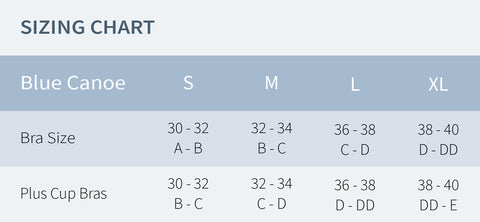Find Your Perfect Fitting Bra
A bra that fits well makes all the difference. An ill-fitting bra can be both uncomfortable and can also ruin the look of an outfit.
Blue Canoe organic bras are designed with comfort in mind first. That is why we only make wire -free bras. Not only are they more comfortable, they are also healthier for your breasts since they do not constrict the many lymph nodes present in the chest area, (an essential part of our immune system).
Since our bras are all made with soft, stretchy, natural materials, the sizing is less strict than bras made with unforgiving synthetics or bras with wires and heavy binding elastics.
Nonetheless, the best place to start in trying to figure out your best bra size is to measure your body.
Measuring for the Best Bra Fit
The first measurement to take is for your band size.
How to Measure Your Band Size
- Put on your best-fitting, non-padded bra.
- Wrap a measuring tape snugly around your rib cage, just beneath your bust line.
- Adjust the tape so that it's parallel to the floor.
- Exhale deeply—you want the smallest measurement possible.
- Add 2” to that measurement.
- The resulting number is your band size.
Next, measure for your cup size.
How to Measure Your Cup Size
- Wrap the measuring tape somewhat loosely around the fullest part of your breasts (nipple level).
- Round to the nearest whole number
Calculate Your Cup Size
- Subtract your band size from your bust measurement.
- If the difference in your bust measurement and band size is 1” then your cup size is A.
- If the difference in your bust measurement and band size is 2” then your cup size is B.
- If the difference in your bust measurement and band size is 3” then your cup size is C.
- If the difference in your bust measurement and band size is 4” then your cup size is D.
- If the difference in your bust measurement and band size is 5” then your cup size is DD.
Now you have your band size and your cup size.
The next step is to match those as closely as you can to our bra sizing chart.
Some of you will fit nicely into our size measurements, while others may not.
For example, if you have a large band size and a small cup size, like 36A, you could go down a band size. Pick a style that has smaller, flatter cups, such as the A100, A140 or one with an adjustable back strap such as H124 which also is a less coverage, smaller cupped bra. A size M in any of these styles would fit.
Conversely, if you have a larger cup size and a smaller band size, say 32 D, you might try one of our Plus Cup bras that have a larger cup compared to band size. (See Plus Cup sizing on our Bra Size Chart). A155 or A161 in size S or M would work.
Also, because our bras are less structured than an underwire or non-stretch bra, the cup sizes are less restrictive. Many of our bras will accommodate one more cup size up from the cup size on the chart. You might choose the A132, A154, H122, R122. A size M in these bras would still accommodate a D cup.
Remember that your bra size might change slightly depending on the brand or type of bra. It may take some trial and error to find the perfect fit. Also keep in mind that bras from the same brand that have been worn regularly for some time will most likely be stretched out and not fit the same as a new bra in the same size. Also, pay attention to the amount of coverage shown in the images of our bras. Some bras have more fabric, while others have less coverage.
Hopefully, if you follow these steps, it will lead you to the best sized bra for you. Once you try a bra, on here are a few telltale signs that you may not be wearing the right bra size.
Too Small
- Spillover on top or side
- Center section doesn't lie flat
- Underwires poke or ride up
Too Big
- Cups wrinkle or gap
- Adjusted straps still slide off
- Band rides up in back
Just Right
- Smooth cups
- Center section lies flat
- Band is low and even



